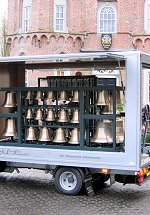
LØGUMKLOSTER - In 2006, a new travelling carillon was built by the Royal Bell-foundry Petit & Fritsen for the Scandinavian Carillon School in Løgumkloster, Denmark. The instrument consists of 50 bells (range c2 - d2 - chromatic to - d6). For demonstration purposes an extra c3 swinging bell weighing 54 kg (119 lbs) has been added. The sound of the bells is very mild. Their volume can be reduced by fixing sheets of Lexan, a strong and lightweight plastic, to the frame with magnets. The overall weight of the truck and bells was not to exceed 3400 kg (7480 lbs).
CONSTRUCTION
Due to its modular construction, the instrument can be moved to almost any location. All modules can pass through a door that is at least 83 cm (33 inches) wide. The first module contains the keyboard, built according to the new WCF Keyboard 2006 world standard, but with two minor adjustments: a keyfall of 35 mm (1.4 inches) for the manual keys and a pedal range that is not entirely two octaves (the highest pedal is an a). Modules to the left and to the right of the keyboard contain the 11 largest bells. The fourth module accommodates the remaining 39 bells. Assembly or reassembly can be done by a single person and takes about two hours. The music stand and the bench must be transported separately from the instrument.
When disassembling the instrument, the wires that connect the keys to the clappers via small directed cranks must be unhooked. The vertical roller bars of the bass bells have been mounted on ball bearings. Pedal couplings are made of bicycle brake cables, which also reduces the weight of the instrument.
INAUGURATION
The inauguration took place on Saturday, November 11, 2006, in Løgumkloster with an outdoor recital by students and professors of the Scandinavian Carillon School. Later on that same day the carillon was set up in a church in order to show its possibilities in playing together with other instruments. At the end of this special concert the carillon was officially presented to the carillon school by Ulla Lunn on behalf of the Maersk Company, which donated money from a special fund called "A. P. Møller og Hustru Chastine Mc-Kinney Møllers Fond til almene Formaal". The reception in the school that marked this special occasion was well-attended.
When the carillon is not 'on the road' the truck and bells will be parked in a new building near the school and close to a large and lovely garden. There, it will also be used for instruction and as a practice instrument for students.
